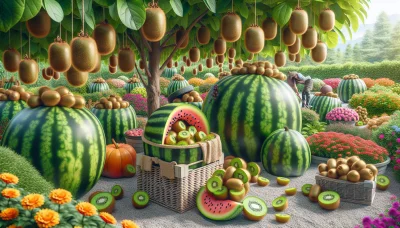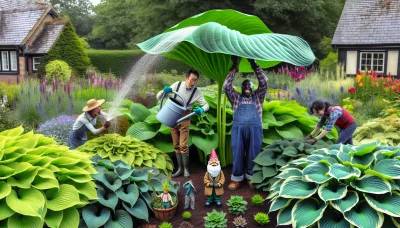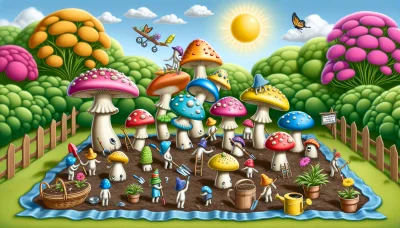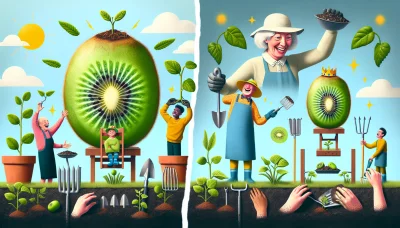Grow strawberries from seeds Quiz
Test Your Knowledge
Question of
How to Grow Strawberries from Seeds
Growing strawberries from seeds can be a rewarding experience for any gardening enthusiast. Not only does it allow you to cultivate these delicious fruits from the very beginning, but it also offers numerous benefits. By growing your own strawberries, you gain control over the environment and inputs your plants are exposed to, ensuring a more organic and pesticide-free harvest. Additionally, starting strawberries from seeds can be more cost-effective than purchasing nursery plants. Plus, the satisfaction of nurturing your strawberries from seed to fruit can't be matched. Embrace the journey of growing your own strawberries for a healthier, more satisfying gardening adventure.
Choosing the Right Strawberry Seeds
Selecting the appropriate variety of strawberry seeds is crucial for ensuring a bountiful harvest. The right choice depends heavily on your specific climate and soil type. Different varieties of strawberries have unique requirements and are adapted to certain environmental conditions. For instance, some varieties thrive in cooler climates, while others are suited for warmer areas. Similarly, soil type can affect the growth, yield, and flavor of your strawberries. By carefully choosing seeds that are compatible with your garden's conditions, you can maximize your chances of success and enjoy delicious, home-grown strawberries.
Step-by-Step Guide to Planting Strawberry Seeds
- Select a well-draining soil mix and a container with drainage holes to prepare for planting.
- Fill your container with the soil mix, leaving about an inch of space from the top.
- Moisten the soil with water until it is damp but not waterlogged.
- Scatter the strawberry seeds evenly over the soil surface. Do not bury them deeply; a light covering of soil is enough, about 1/8 inch deep.
- Gently press the soil over the seeds to ensure they make good contact with the moist soil.
- Cover the container with a clear plastic wrap or a plastic dome to maintain humidity, which is crucial for germination.
- Place the container in a warm, bright area but out of direct sunlight. Strawberry seeds germinate best at temperatures between 60-75°F (15-24°C).
- Keep the soil moist but not soggy. Use a spray bottle to mist the soil whenever it begins to dry out.
- Watch for germination in 2-3 weeks. Once the seeds sprout, remove the plastic cover and move the container to a location where the seedlings will receive plenty of indirect sunlight.
- When the seedlings have developed their third true leaf, they can be carefully transplanted into individual pots or into the garden if the outdoor conditions are suitable.
- Continue to water the strawberry plants regularly, allowing the soil to slightly dry out between watering to encourage strong root development.
Caring for Your Strawberry Plants
To ensure your strawberry plants thrive, it's essential to provide them with the right growing conditions. First and foremost, strawberries love sunlight. Make sure they are planted in a spot where they can receive at least six to eight hours of direct sunlight each day. When it comes to watering, strawberries require moist, well-drained soil. Aim to keep the soil consistently damp without over-saturating, as too much water can lead to root rot. A good rule of thumb is to water them deeply once a week, or more frequently during particularly dry spells. Fertilization is another key aspect of strawberry plant care. Feed your plants with a balanced, all-purpose fertilizer in the early spring when they start actively growing, and then again in midsummer to help nourish fruit production. With the right balance of sunlight, watering, and fertilization, your strawberry plants will be set to produce sweet, juicy fruits for you to enjoy.
Common Challenges in Growing Strawberries from Seeds
- Pests: Strawberries can attract a variety of pests such as slugs, snails, and birds. To combat these, consider using organic slug pellets, copper tape for pots, or netting to protect your plants from birds.
- Diseases: Fungal diseases like powdery mildew and leaf spot are common. Ensure good air circulation around your plants and avoid overhead watering to keep the foliage dry. Using fungicides according to the manufacturer's instructions can also be beneficial.
- Environmental Stress: Strawberries require full sun, well-drained soil, and regular watering. To prevent environmental stress, ensure your strawberries are planted in a suitable location, use mulch to retain moisture, and consider using a drip irrigation system to maintain consistent soil moisture levels.
- Soil Nutrition: Poor fruit development can be a sign of nutrient deficiency. Use a balanced fertilizer designed for fruit-bearing plants, and consider getting your soil tested to tailor your fertilization practices more closely to the needs of your strawberries.
Harvesting Your Strawberries
For the best flavor and yield, strawberries should be harvested in the morning, after the dew has dried but before the day heats up. This timing helps in preserving their freshness and natural sugars, enhancing their taste. It's crucial to pick strawberries when they are fully red, with no white or green parts, as they do not continue to ripen after being picked. Gently twist the berries off the stem to avoid damaging the plant or the fruit. Regular harvesting encourages the plant to produce more fruit throughout the season. Remember, the peak season for harvesting strawberries varies depending on your geographical location, so it's wise to keep an eye on your plants as the season progresses.
FAQs on Growing Strawberries from Seeds
| Question | Answer |
|---|---|
| How long does it take for strawberry seeds to germinate? | Strawberry seeds can take 2 to 3 weeks to germinate under optimal conditions. |
| What are the optimal conditions for germinating strawberry seeds? | Strawberry seeds require bright light, a temperature of 60-75°F (15-24°C), and moist soil to germinate successfully. |
| Do strawberry plants need full sun? | Yes, strawberry plants thrive in full sun, requiring at least 6 to 8 hours of direct sunlight per day. |
| How often should I water strawberry plants? | Water strawberry plants about 1 inch per week, ensuring the soil is moist but not waterlogged. |
| When is the best time to plant strawberry seeds indoors? | The best time to plant strawberry seeds indoors is 8 to 10 weeks before the last frost date in your area. |
| Can I grow strawberries in containers? | Yes, strawberries can be successfully grown in containers, making sure they have adequate drainage and space to grow. |
| How do I protect my strawberry plants from pests? | Use netting to protect your plants from birds and insects, and employ organic pest control methods to deal with common pests like slugs and aphids. |












